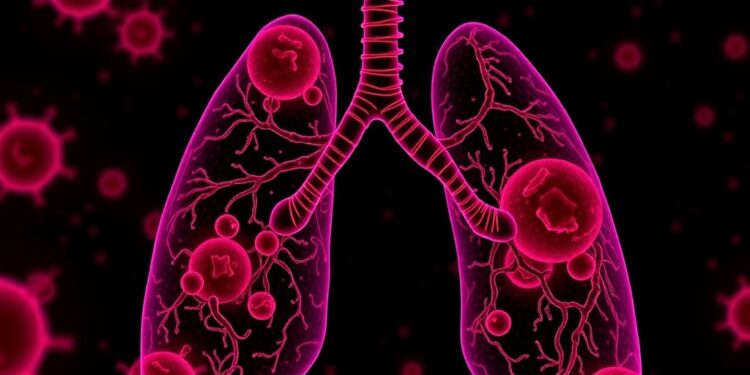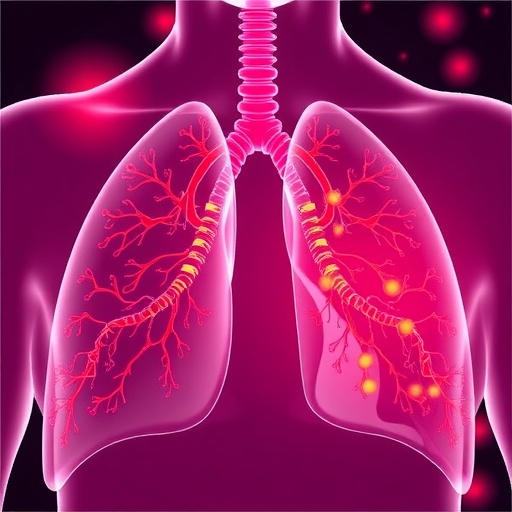
In a groundbreaking study from the Francis Crick Institute, researchers have unveiled a remarkable capability of small cell lung cancer (SCLC) cells – the ability to develop an independent electrical network similar to that found in the body’s nervous system. This distinctive feature could significantly influence how these cancer cells proliferate and spread throughout the body, presenting a deeper understanding of the challenges in treating this aggressive form of cancer. The new research, published in the esteemed journal Nature, highlights critical advances in understanding the biological underpinnings of SCLC, which is notoriously difficult to diagnose and treat effectively.
Small cell lung cancer is a highly aggressive cancer that often presents severe treatment challenges. SCLC predominantly arises from neuroendocrine (NE) cells, which serve crucial roles in regulating air and blood flow within the lungs. The researchers sought to investigate the underlying mechanisms of SCLC aggressiveness by examining electrical activities within both human and murine samples. Their objective was to uncover whether these electrical signals could relate to the malignancy’s invasive nature and its tendency to metastasize.
Utilizing advanced neuroscience techniques, the research team discovered that the SCLC cells had essentially gone ‘off the grid’. In other words, they were generating their own electrical activity and constructing a self-sufficient electrical network that could operate independently of the surrounding nerve fibers. This characteristic suggests that SCLC cells might not only escape the control of their local environment but also enhance their capacity to spread, making them resilient to traditional treatment strategies.
The research further delved into the energy demands associated with these electrical activities. Electricity generation within the tumor requires substantial energy, prompting the researchers to analyze how SCLC cells were obtaining this energy. As the cancer progressed, changes in gene expression were noted; specifically, some NE cells were losing their identity and evolving into non-neuroendocrine (non-NE) cancer cells. This transition is of paramount importance, as it reshapes the cellular landscape of the tumor and influences its growth dynamics.
In exploring the ecological interactions within the tumor, the researchers discovered that there was a collaborative dynamic between NE and non-NE cancer cells that parallels the relationship seen between neurons and astrocytes in the brain. The NE cells demonstrated electrical communication, while the non-NE cells were involved in creating a supportive infrastructure, facilitating tumor growth. This synergy involved the exchange of lactate, a critical energy substrate, which was shuttled from non-NE cells to NE cells to support and sustain their electrical activity.
This interdependence underscores how tumors can develop complex organizational structures that are less reliant on traditional signaling mechanisms. When investigative procedures employed tetrodotoxin (TTX), a potent neurotoxin known for its ability to block electrical signaling, the researchers observed that the inhibition of electrical activity significantly curtailed the NE cells’ tumor-forming potential without affecting the non-NE cells. This suggests that electrical activity is not only a characteristic of aggressive SCLC but also a critical driver for its proliferation and spread.
In analyzing clinical samples, the team detected elevated markers of electrical activity in human SCLC cells compared to adjacent healthy tissues. This correlation reinforced the notion that increased electrical activity is a hallmark of SCLC and could potentially serve as a diagnostic or prognostic indicator for the disease. Furthermore, progress in the cancer manifested as non-NE cells began to upregulate markers associated with lactate production, indicating an adaptation in energy sourcing within the tumor environment, a characteristic distinct from many other forms of cancer.
The insights gained from this research highlight a paradigm shift in our understanding of cancer biology, particularly with regard to how these malignant cells can exploit neurological properties to fuel their aggressive growth. Such findings pave the way for exploring potential vulnerabilities inherent in this unique electrical activity. Targeting the mechanisms that facilitate this autonomy could yield new therapeutic strategies aimed at disrupting the intricate network that sustains the malignancy.
Leading author Paola Peinado Fernandez emphasized the significance of these findings, stating that the ability of NE cells in SCLC to generate their own electrical supply marks a profound advancement in our understanding of cancer behavior. This acquisition of electrical independence, she explains, may contribute to a reduction in dependency on the surrounding tumor environment, thus enhancing the cancer’s aggressiveness.
Leanne Li, the head of the Cancer-Neuroscience Laboratory, echoed these sentiments by highlighting the innovative fusion of cancer and neuroscience research techniques that have allowed for this expanded perspective. The implications of these findings extend beyond small cell lung cancer, as the research team is eager to explore how electrical activity may manifest in other cancer types, potentially unveiling broader applications for future treatment options.
The ongoing research endeavors at the Francis Crick Institute are not merely a reflection of academic inquiry but represent a crucial advance in cancer research. As researchers dissect the complexities of tumor microenvironments and their electrical properties, there remains the potential for innovative interventions that could significantly alter the landscape of cancer treatment as we know it.
Understanding these biological nuances is vital, as they may serve as foundations for developing targeted therapies against highly aggressive cancers that have few effective treatment options. By shedding light on the role of electrical networks in cancer progression, the team at the Crick Institute has laid the groundwork for future breakthroughs that could revolutionize how we approach treatment for patients with small cell lung cancer and beyond.
In conclusion, as the medical community braces for what these findings may lead to, the implications for therapeutic advances in oncology are seemingly limitless. What has emerged is a compelling narrative illustrating how scientific inquiry continues to illuminate the intricate connections between cancer and biology, opening new avenues for understanding and treatment.
Subject of Research: Small Cell Lung Cancer
Article Title: Intrinsic electrical activity drives small cell lung cancer progression
News Publication Date: 12-Feb-2025
Web References: Nature Article
References: Peinado, P., Stazi, M., Ballabio, C., et al. (2025). Intrinsic electrical activity drives small cell lung cancer progression. Nature.
Image Credits: Francis Crick Institute
Keywords: Small cell lung cancer, electrical activity, neuroendocrine cells, cancer metastasis, therapy development, tumor microenvironment.
Tags: aggressive cancer treatment obstaclesbiological mechanisms of SCLCchallenges in lung cancer treatmentelectrical signaling in cancer cellsFrancis Crick Institute studyinnovative lung cancer therapiesmetastasis in small cell lung cancerNature journal lung cancer publicationneuroendocrine cells in SCLCSCLC electrical network discoverysmall cell lung cancer researchunderstanding lung cancer proliferation





